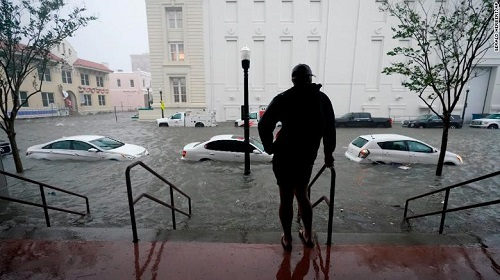Analysts at AM Best do not expect Hurricane Sally to constitute a major insurance industry loss due to its large flood component, which will mainly be covered by the US National Flood Insurance Program (NFIP).

AP Photo/Gerald Herbert
Hurricane Sally made landfall on the US Gulf Coast early on Wednesday morning, dropping massive amounts of rain in Alabama and the Florida Panhandle.
Because of its slow pace—about three miles per hour— Sally has already left more than 24 inches of rain in some areas, which could increase to nearly 35 inches by the end of the storm.
The National Hurricane Center (NHC) described the flooding as “catastrophic and life-threatening” and hundreds of thousands of residents were left without power.
But flood remains an underinsured peril across many of the impacted areas, meaning the gap between insured and economic losses is likely to be wide.
According to the NFIP estimates as of July 2019, only eight of the roughly 50 counties vulnerable to moderate to high flash flood risk from Sally have more than 25% of properties insured.
As more than two thirds of flood coverage written in Alabama is federal, flood losses for the NFIP will be significant, but this could also signal significant losses for the NFIP’s reinsurers and investors on its flood-related cat bonds.
In addition to using the capital markets to manage its exposure, the NFIP has purchased reinsurance covers of more than $2 billion. The reinsurance program for 2020 attaches for NFIP losses greater than $4 billion.
Although a major flood event would reduce some direct loss exposure to the insurance industry, AM Best also expects significant auto claims from damage to automobiles due to storm surge, particularly if flooding spreads to Georgia and the Carolinas.
AM Best further notes that the Alabama private flood coverage market is extremely concentrated, with just ten companies accounting for around 91% of premium in the Alabama private flood market.
The NFIP provides a majority of coverage for flood (82%), but some insurers have significant exposure to private flood, especially the ten market share leaders.
Auto damage might result in more of a direct loss event for insurers, but analysts believe most affected insurers are geographically diverse, with only seven companies have concentrations larger than 10% in this line in Alabama.
And in terms of homeowners’ lines, losses are likely to be more limited due to Sally being more of a flood than a wind event.
However, AM Best notes that a standard homeowner’s policy will cover water damage from rain as long as the storm has ‘opened up’ a hole in the roof.


